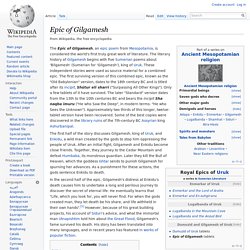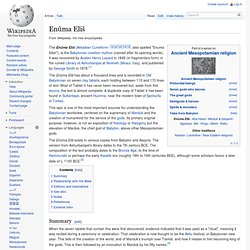

Mesopotamian Mythology. Sumerian creation myth 1600 BC. The earliest record of the Sumerian creation and flood is found on a single fragmentary tablet excavated in Nippur, sometimes called the Eridu Genesis.

It is written in the Sumerian language and dated to around 1600 BC during the first Babylonian dynasty, where the language of writing and administration was still Sumerian. Other Sumerian creation myths from around this date are called the Barton Cylinder, the Debate between sheep and grain and the Debate between Winter and Summer, also found at Nippur.[1] Summary[edit] When the tablet resumes it is describing the flood. A terrible storm rocks the huge boat for seven days and seven nights, then Utu (the Sun god) appears and Zi-ud-sura creates an opening in the boat, prostrates himself, and sacrifices oxen and sheep. Legacy[edit] Two flood myths with many similarities to the Sumerian story are the Utnapishtim episode in the Epic of Gilgamesh and the Genesis flood narrative found in the Bible.
Ziusudra and Xisuthros[edit] See also[edit] Family tree of the Babylonian gods. Epic of Gilgamesh. The Epic of Gilgamesh, an epic poem from Mesopotamia, is considered the world's first truly great work of literature.

The literary history of Gilgamesh begins with five Sumerian poems about 'Bilgamesh' (Sumerian for 'Gilgamesh'), king of Uruk. These independent stories were used as source material for a combined epic. The first surviving version of this combined epic, known as the "Old Babylonian" version, dates to the 18th century BC and is titled after its incipit, Shūtur eli sharrī ("Surpassing All Other Kings").
Only a few tablets of it have survived. The later "Standard" version dates from the 13th to the 10th centuries BC and bears the incipit Sha naqba īmuru ("He who Saw the Deep", in modern terms: "He who Sees the Unknown"). The first half of the story discusses Gilgamesh, king of Uruk, and Enkidu, a wild man created by the gods to stop him oppressing the people of Uruk. History[edit] Versions of the epic[edit] Standard Akkadian version[edit] (Based on Andrew George's translation) Enûma Eliš. This epic is one of the most important sources for understanding the Babylonian worldview, centered on the supremacy of Marduk and the creation of humankind for the service of the gods.

Its primary original purpose, however, is not an exposition of theology or theogony but the elevation of Marduk, the chief god of Babylon, above other Mesopotamian gods. The Enûma Eliš exists in various copies from Babylon and Assyria. The version from Ashurbanipal's library dates to the 7th century BCE. The composition of the text probably dates to the Bronze Age, to the time of Hammurabi or perhaps the early Kassite era (roughly 18th to 16th centuries BCE), although some scholars favour a later date of c. 1100 BCE.[2] Summary[edit] When the seven tablets that contain this were first discovered, evidence indicated that it was used as a "ritual", meaning it was recited during a ceremony or celebration. The title, meaning "when on high", is the incipit. Relationship with the Bible[edit] See also[edit]